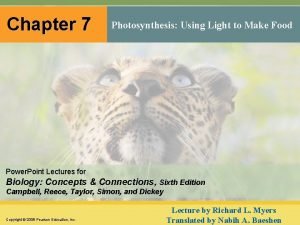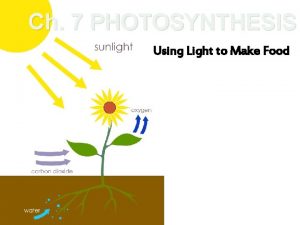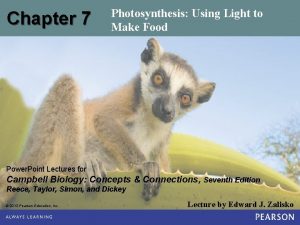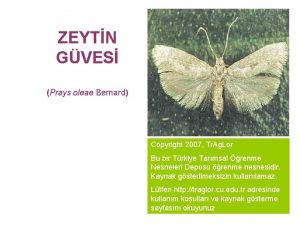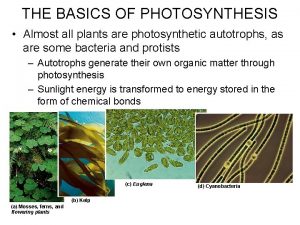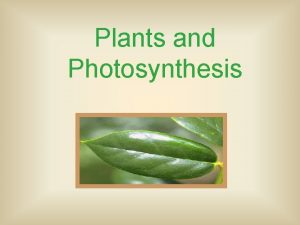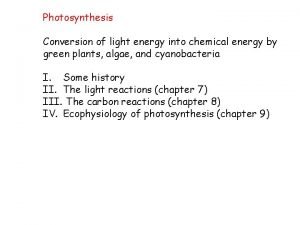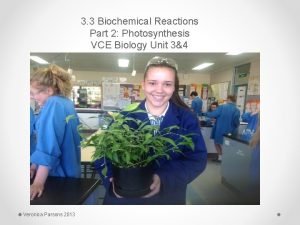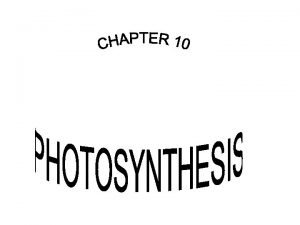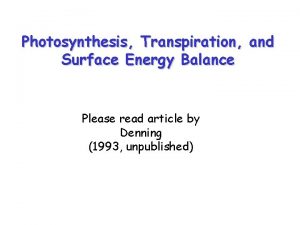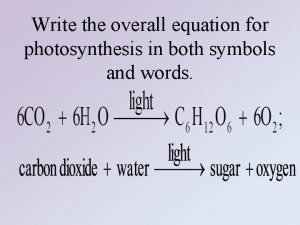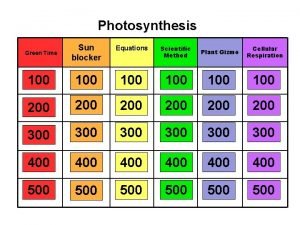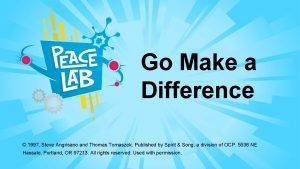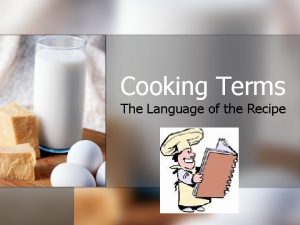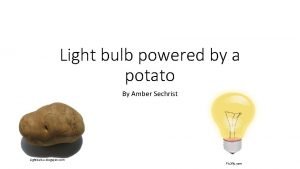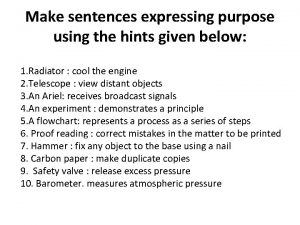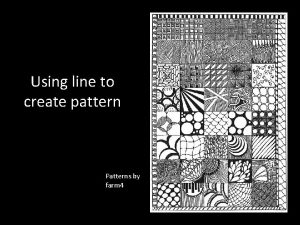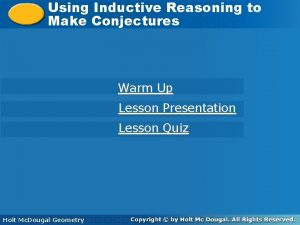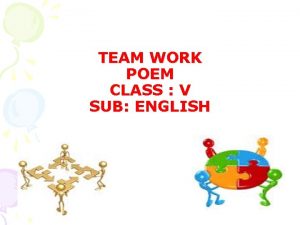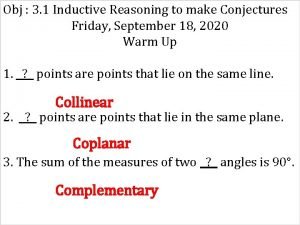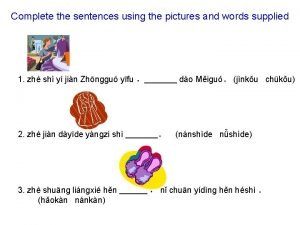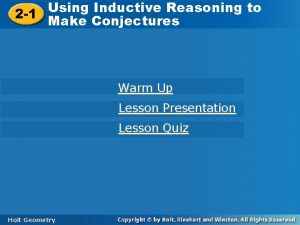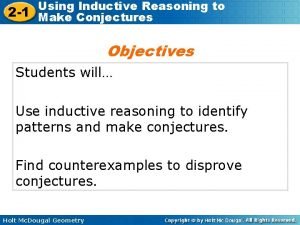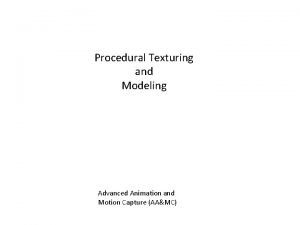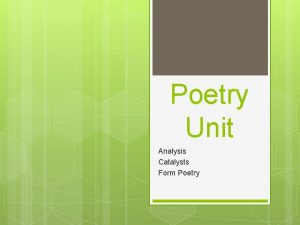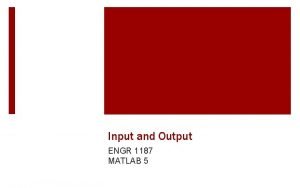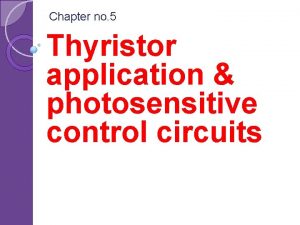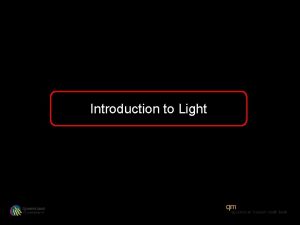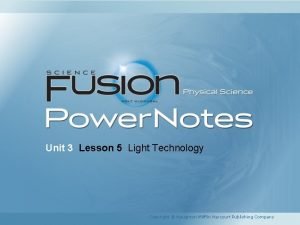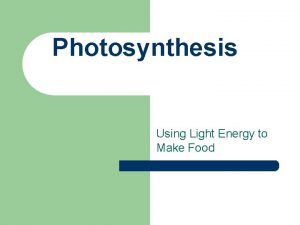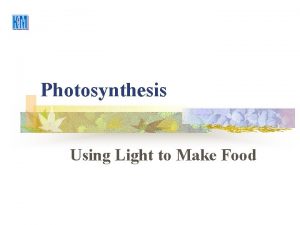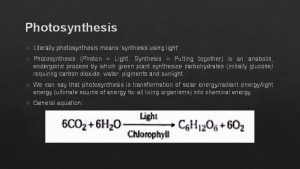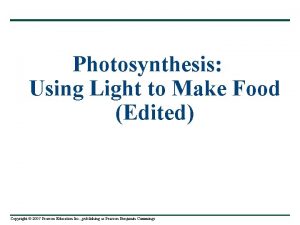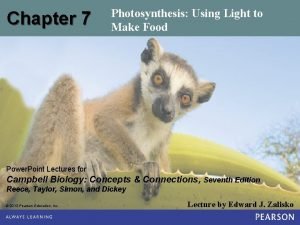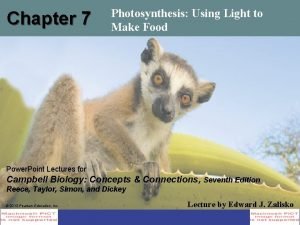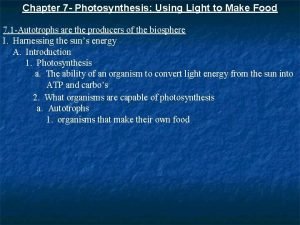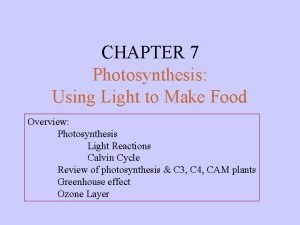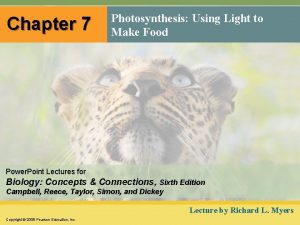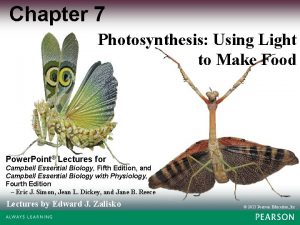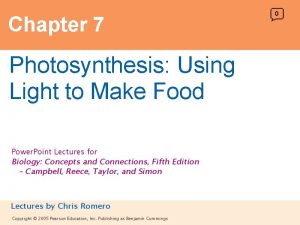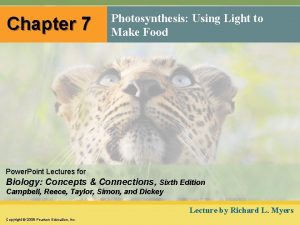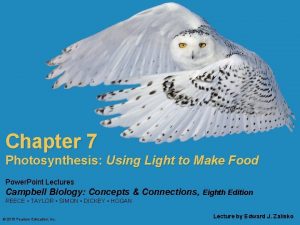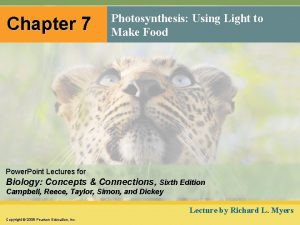Photosynthesis Using Light to Make Food Copyright 2007



































![The spatial organization of chemiosmosis • Differs in chloroplasts and mitochondria Key Higher [H+] The spatial organization of chemiosmosis • Differs in chloroplasts and mitochondria Key Higher [H+]](https://slidetodoc.com/presentation_image_h/3079f76a6b626ec9fd1da2910277fed4/image-36.jpg)















- Slides: 51

Photosynthesis: Using Light to Make Food Copyright © 2007 Pearson Education Inc. , publishing as Pearson Benjamin Cummings

Photosynthesis: • The process that converts solar energy into chemical energy Producers of the Biosphere: • Plants and other autotrophs Plants are photoautotrophs: • They use the energy of sunlight • They make organic molecules from water and carbon dioxide Copyright © 2007 Pearson Education Inc. , publishing as Pearson Benjamin Cummings

Figure 10. 1 Copyright © 2007 Pearson Education Inc. , publishing as Pearson Benjamin Cummings


Biology and Society: Plant Power for Power Plants • All food consumed by humans can be traced back to: – Photosynthetic plants. • An “energy plantation” – Is a renewable energy source. Copyright © 2007 Pearson Education, Inc. publishing as Pearson Benjamin Cummings

Figure 7. 1

Photosynthesis occurs in: • Plants: • Predominant producer of food on land • Algae • Some unicellualr protists, e. g. egulina • Some prokaryotes: • Cynobacteria • Sulfur bacteria Copyright © 2007 Pearson Education Inc. , publishing as Pearson Benjamin Cummings

(a) Plants (c) Unicellular protist 10 m (e) Pruple sulfur bacteria Figure 10. 2 (b) Multicellular algae Copyright © 2007 Pearson Education Inc. , publishing as Pearson Benjamin Cummings (d) Cyanobacteria 40 m 1. 5 m

Chloroplasts: Sites of Photosynthesis • Photosynthesis – Occurs in chloroplasts. • Chloroplasts – Are found in the interior cells of leaves. – Contain stroma, a thick fluid. – Contain thylakoids, membranous sacs. Copyright © 2007 Pearson Education Inc. , publishing as Pearson Benjamin Cummings

Figure 7. 3

The Overall Equation for Photosynthesis • The reactants and products of the reaction Copyright © 2007 Pearson Education Inc. , publishing as Pearson Benjamin Cummings

Photosynthesis as a Redox Process Photosynthesis is a redox process • Water is oxidized • Carbon dioxide is reduced Copyright © 2007 Pearson Education Inc. , publishing as Pearson Benjamin Cummings

A Photosynthesis Road Map • Photosynthesis is composed of two processes: – The light reactions: • convert solar energy to chemical energy (ATP & NADPH). – The Calvin cycle: • makes sugar from carbon dioxide. Copyright © 2007 Pearson Education Inc. , publishing as Pearson Benjamin Cummings

Figure 7. 4

The light reactions • Occur in the grana • Split water releasing oxygen • Convert light energy into chemical energy by: – Producing ATP and – Forming NADPH Copyright © 2007 Pearson Education Inc. , publishing as Pearson Benjamin Cummings

The Calvin cycle • Occurs in the stroma • Forms sugar from carbon dioxide, using: – ATP for energy, and – NADPH as reducing power Copyright © 2007 Pearson Education Inc. , publishing as Pearson Benjamin Cummings

An overview of photosynthesis H 2 O CO 2 Light NADP + P LIGHT REACTIONS CALVIN CYCLE ATP NADPH Chloroplast Figure 10. 5 O 2 Copyright © 2007 Pearson Education Inc. , publishing as Pearson Benjamin Cummings [CH 2 O] (sugar)

The Nature of Sunlight • Sunlight is a type of energy called: – Radiation or electromagnetic energy. • The full range of radiation is called: – The electro-magnetic spectrum. • Wavelength: – Is the distance between the crests of waves – Determines the type of electromagnetic energy Copyright © 2007 Pearson Education Inc. , publishing as Pearson Benjamin Cummings

The visible light spectrum includes: • The colors of light we can see • The wavelengths that drive photosynthesis Copyright © 2007 Pearson Education Inc. , publishing as Pearson Benjamin Cummings

Figure 7. 5

Photosynthetic Pigments: The Light Receptors Pigments • Are substances that absorb visible light • Reflect light, which include the colors we see Light Reflected Light Chloroplast Absorbed light Granum Transmitted light Copyright © 2007 Pearson Education Inc. , publishing as Pearson Benjamin Cummings

The spectrophotometer • Is a machine that: – Sends light through pigments – Measures the fraction of light transmitted at each wavelength Copyright © 2007 Pearson Education Inc. , publishing as Pearson Benjamin Cummings

Chloroplast Pigments • Chloroplasts contain several pigments: – Chlorophyll a: Is the main photosynthetic pigment – Chlorophyll b: Is an accessory pigment – Carotenoids: An accessory pigment (protective) Copyright © 2007 Pearson Education Inc. , publishing as Pearson Benjamin Cummings

How Photosystems Harvest Light Energy • Light also behaves as photons • A photons is: – A discrete quantity of energy. • The shorter the wavelength the greater the photon energy Copyright © 2007 Pearson Education Inc. , publishing as Pearson Benjamin Cummings

• When chlorophyll molecules absorb photons: – Electrons in the pigment gain energy – Electrons are raised from ground state to excited (unstable) state – Electrons lose excess energy (return to ground state) – The energy is released (light/heat) and used. Copyright © 2007 Pearson Education Inc. , publishing as Pearson Benjamin Cummings

Figure 7. 9

Brak Slide 3/22/11 Copyright © 2007 Pearson Education Inc. , publishing as Pearson Benjamin Cummings

Thylakoid-Membrane Photosystems • Photosystem: – An organized group (few hundreds) of chlorophyll and other molecules – Composed of a protein complex called a reaction center complex – The reaction ceneter: • Surrounded by a number of light-harvesting complexes • Include a pair of chlorophyll a molecules • Contains a molecule capable of accepting electrons & becoming reduced; it is called “primary electron acceptor” Copyright © 2007 Pearson Education Inc. , publishing as Pearson Benjamin Cummings

Thylakoid-Membrane Photosystems • Light harvesting complex: – Consists of various pigments molecules (chlorophyll a, b, & carotenoid) – The pigments molecules are bound to proteins • Two photosystems: – Water-splitting photosystem – NADPH-producing photosystem • Both photosystems: – Cooperate in light reaction, and – Produce energy Copyright © 2007 Pearson Education Inc. , publishing as Pearson Benjamin Cummings

The Photosystem Thylakoid Photosystem STROMA Photon Thylakoid membrane Light-harvesting complexes Reaction center Primary election acceptor e– Transfer of energy Figure 10. 12 Copyright © 2007 Pearson Education Inc. , publishing as Pearson Benjamin Cummings Special chlorophyll a molecules Pigment molecules THYLAKOID SPACE (INTERIOR OF THYLAKOID)

The light-harvesting complexes • Consist of pigment molecules bound to particular proteins • Funnel the energy of photons of light to the reaction center Copyright © 2007 Pearson Education Inc. , publishing as Pearson Benjamin Cummings

When a reaction-center chlorophyll molecule absorbs energy • One of its electrons gets pumped up to a primary electron acceptor The thylakoid membrane • Is populated by two types of photosystems, I and II Copyright © 2007 Pearson Education Inc. , publishing as Pearson Benjamin Cummings

Noncyclic Electron Flow Noncyclic (linear) electron flow • Is the primary pathway of energy transformation in the light reactions Copyright © 2007 Pearson Education Inc. , publishing as Pearson Benjamin Cummings

Produces NADPH, ATP, and oxygen H 2 O CO 2 Light NADP+ ADP CALVIN CYCLE LIGHT REACTIONS ATP NADPH O 2 [CH 2 O] (sugar) Primary acceptor 2 H+ + O 2 e H 2 O Pq on tr ansp Fd ort c hain e NADP+ NADPH PC e– 5 + H+ P 700 P 680 Light ATP Photosystem II (PS II) Copyright © 2007 Pearson Education Inc. , publishing as Pearson Benjamin Cummings NADP+ + 2 H+ reductase 3 6 Figure 10. 13 8 e– Cytochrome complex e– Light 1 7 4 Elec tr 2 El Tra ectro ns n ch port ain Photosystem-I (PS I)

Chemiosmosis in Chloroplasts and Mitochondria Chloroplasts and mitochondria • Generate ATP by the same basic mechanism, chemiosmosis • But use different sources of energy to accomplish this (electrons from glucose Copyright © 2007 Pearson Education Inc. , publishing as Pearson Benjamin Cummings
![The spatial organization of chemiosmosis Differs in chloroplasts and mitochondria Key Higher H The spatial organization of chemiosmosis • Differs in chloroplasts and mitochondria Key Higher [H+]](https://slidetodoc.com/presentation_image_h/3079f76a6b626ec9fd1da2910277fed4/image-36.jpg)
The spatial organization of chemiosmosis • Differs in chloroplasts and mitochondria Key Higher [H+] Lower [H+] Chloroplast Mitochondrion CHLOROPLAST STRUCTURE MITOCHONDRION STRUCTURE Intermembrance space Membrance Matrix H+ Diffusion Electron transport chain ATP Synthase ADP+ Figure 10. 16 Copyright © 2007 Pearson Education Inc. , publishing as Pearson Benjamin Cummings Thylakoid space Stroma P H+ ATP

In both organelles • Redox reactions of electron transport chains generate a H+ gradient across a membrane ATP synthase • Uses this proton-motive force to make ATP Copyright © 2007 Pearson Education Inc. , publishing as Pearson Benjamin Cummings

The light reactions and chemiosmosis: the organization of the thylakoid membrane H 2 O CO 2 LIGHT NADP+ ADP LIGHT REACTOR CALVIN CYCLE ATP NADPH STROMA (Low H+ concentration) O 2 [CH 2 O] (sugar) Cytochrome Photosystem II complex Photosystem I Light 2 H+ NADP+ reductase Fd 3 NADP+ + 2 H+ NADPH + H+ Pq H 2 O THYLAKOID SPACE (High H+ concentration) Pc 2 1⁄ 1 2 O 2 +2 H+ To Calvin cycle STROMA (Low H+ concentration) Thylakoid membrane ATP synthase ADP ATP P Figure 10. 17 Copyright © 2007 Pearson Education Inc. , publishing as Pearson Benjamin Cummings H+

The Calvin cycle uses ATP and NADPH to convert CO 2 to sugar The Calvin cycle: • Is similar to the citric acid cycle • Occurs in the stroma Copyright © 2007 Pearson Education Inc. , publishing as Pearson Benjamin Cummings

The Calvin cycle has three phases • Carbon fixation • Reduction • Regeneration of the CO 2 acceptor Copyright © 2007 Pearson Education Inc. , publishing as Pearson Benjamin Cummings

The Calvin cycle Light H 2 O Input 3 (Entering one CO 2 at a time) CO 2 NADP+ ADP LIGHT REACTION CALVIN CYCLE ATP Phase 1: Carbon fixation NADPH O 2 Rubisco [CH 2 O] (sugar) 3 P Ribulose bisphosphate (Ru. BP) P Short-lived intermediate P P 6 3 -Phosphoglycerate 6 ATP 6 ADP CALVIN CYCLE 3 ADP 3 ATP Phase 3: Regeneration of the CO 2 acceptor (Ru. BP) 6 P P 1, 3 -Bisphoglycerate 6 NADPH+ 6 P P 5 (G 3 P) 6 P Glyceraldehyde-3 -phosphate (G 3 P) 1 Figure 10. 18 Copyright © 2007 Pearson Education Inc. , publishing as Pearson Benjamin Cummings G 3 P (a sugar) Output P Glucose and other organic compounds Phase 2: Reduction

Alternative mechanisms of carbon fixation have evolved in hot, arid climates On hot, dry days, plants close their stomata • Conserving water but limiting access to CO 2 • Causing oxygen to build up Copyright © 2007 Pearson Education Inc. , publishing as Pearson Benjamin Cummings

Water-Saving Adaptations of C 4 and CAM Plants • C 3 plants (Soybean, oat, wheat, rice): – Use CO 2 (Calvin cycle) directly from the air. – Are very common and widely distributed. – Low production during hot season – Stomata closed to conserve water – Less CO 2 and less photosynthesis Copyright © 2007 Pearson Education Inc. , publishing as Pearson Benjamin Cummings

• C 4 plants (Corn, sorghum, sugarcane) – Close their stomata to save water during hot and dry weather. – Can still carry out photosynthesis. – Enzymatic binding of CO 2 into 4 -C compound – 4 -C compound donates CO 2 to Calvin cycle in a nearby cell Copyright © 2007 Pearson Education Inc. , publishing as Pearson Benjamin Cummings

C 4 leaf anatomy and the C 4 pathway Mesophyll cell Photosynthetic cells of C 4 plant leaf Bundlesheath cell CO CO 2 2 PEP carboxylase PEP (3 C) ADP Oxaloacetate (4 C) Vein (vascular tissue) Malate (4 C) C 4 leaf anatomy Bundle. Sheath cell ATP Pyruate (3 C) CO 2 Stoma CALVIN CYCLE Sugar Vascular tissue Figure 10. 19 Copyright © 2007 Pearson Education Inc. , publishing as Pearson Benjamin Cummings

• CAM plants (Pineapple, cacti, succulent plants) – Open stomata only at night to conserve water – Carry photosynthesis during the day – CO 2 is incorporated into 4 -C compound – 4 C compound donates CO 2 to Calvin cycle during the day Copyright © 2007 Pearson Education Inc. , publishing as Pearson Benjamin Cummings

The CAM pathway is similar to the C 4 pathway Pineapple Sugarcane C 4 Mesophyll Cell Organic acid Bundlesheath cell (a) Spatial separation of steps. In C 4 plants, carbon fixation and the Calvin cycle occur in different Figure 10. 20 types of cells. CAM CO 2 CALVIN CYCLE CO 2 1 CO 2 incorporated Organic acid into four-carbon organic acids (carbon fixation) 2 Organic acids release CO 2 to Calvin cycle Sugar Copyright © 2007 Pearson Education Inc. , publishing as Pearson Benjamin Cummings CALVIN CYCLE Sugar Night Day (b) Temporal separation of steps. In CAM plants, carbon fixation and the Calvin cycle occur in the same cells at different times.

The Importance of Photosynthesis: A Review A review of photosynthesis Light reaction Calvin cycle H 2 O CO 2 Light NADP+ ADP +P 1 Ru. BP Photosystem II Electron transport chain Photosystem I ATP NADPH Chloroplast Figure 10. 21 3 -Phosphoglycerate G 3 P Starch (storage) Amino acids Fatty acids O 2 Light reactions: • Are carried out by molecules in the thylakoid membranes • Convert light energy to the chemical energy of ATP and NADPH • Split H 2 O and release O 2 to the atmosphere Copyright © 2007 Pearson Education Inc. , publishing as Pearson Benjamin Cummings Sucrose (export) Calvin cycle reactions: • Take place in the stroma • Use ATP and NADPH to convert CO 2 to the sugar G 3 P • Return ADP, inorganic phosphate, and NADP+ to the light reactions

The Environmental Impact of Photosynthesis Copyright © 2007 Pearson Education Inc. , publishing as Pearson Benjamin Cummings

• Photosynthesis has an enormous impact on the atmosphere. – It swaps O 2 for CO 2. Copyright © 2007 Pearson Education Inc. , publishing as Pearson Benjamin Cummings

Organic compounds produced by photosynthesis • Provide the energy and • Building material for ecosystems Copyright © 2007 Pearson Education Inc. , publishing as Pearson Benjamin Cummings
 Chapter 7 photosynthesis using light to make food
Chapter 7 photosynthesis using light to make food Photosynthesis using light to make food
Photosynthesis using light to make food Using light to make food
Using light to make food What is the word equation of photosynthesis
What is the word equation of photosynthesis Green plants make their own food by photosynthesis
Green plants make their own food by photosynthesis Light light light chapter 23
Light light light chapter 23 Into the light chapter 22
Into the light chapter 22 Light light light chapter 22
Light light light chapter 22 Copyright 2007
Copyright 2007 Pearson
Pearson Inputs of light reactions in photosynthesis
Inputs of light reactions in photosynthesis Light reactions photosynthesis
Light reactions photosynthesis Chemical form of energy
Chemical form of energy Light dependent phase of photosynthesis
Light dependent phase of photosynthesis Electron transport in photosynthesis
Electron transport in photosynthesis Structure of chlorophyll
Structure of chlorophyll Photosynthesis transforms light energy into chemical energy
Photosynthesis transforms light energy into chemical energy Histogram in excel 2007
Histogram in excel 2007 Unit 2 food food food
Unit 2 food food food Grazing food chain diagram
Grazing food chain diagram Write the overall equation for photosynthesis using words
Write the overall equation for photosynthesis using words The food that plants produce during photosynthesis is
The food that plants produce during photosynthesis is Axolotl food
Axolotl food Make the lie big
Make the lie big Go make a difference in the world
Go make a difference in the world Dawes plan
Dawes plan Pare cooking definition
Pare cooking definition Light a bulb with potato
Light a bulb with potato Put out the light and then
Put out the light and then Membrane bound organelles
Membrane bound organelles Or the bending of light and the bouncing off of light
Or the bending of light and the bouncing off of light Which materials let light through
Which materials let light through Make sentences using the past simple and past continuous
Make sentences using the past simple and past continuous Make sentences expressing purpose using the hints
Make sentences expressing purpose using the hints How do you make predictions using experimental probability
How do you make predictions using experimental probability Pattern using line
Pattern using line Using inductive reasoning to make conjectures answers
Using inductive reasoning to make conjectures answers Acrostic poem for team
Acrostic poem for team Using inductive reasoning to make conjectures
Using inductive reasoning to make conjectures Make predictions using theoretical probability
Make predictions using theoretical probability Complete the sentences with th
Complete the sentences with th 2-1 using inductive reasoning to make conjectures
2-1 using inductive reasoning to make conjectures Using inductive reasoning to make conjectures
Using inductive reasoning to make conjectures Meaning of acrostic poem
Meaning of acrostic poem Leave taking expression is used to ....
Leave taking expression is used to .... How to make a roulette wheel in c using srand
How to make a roulette wheel in c using srand Acrostic poem about catalyst
Acrostic poem about catalyst How to make a table in matlab using fprintf
How to make a table in matlab using fprintf How to make money using machine learning
How to make money using machine learning Thyristor application
Thyristor application Introduction of light
Introduction of light Lesson 5 using light
Lesson 5 using light
